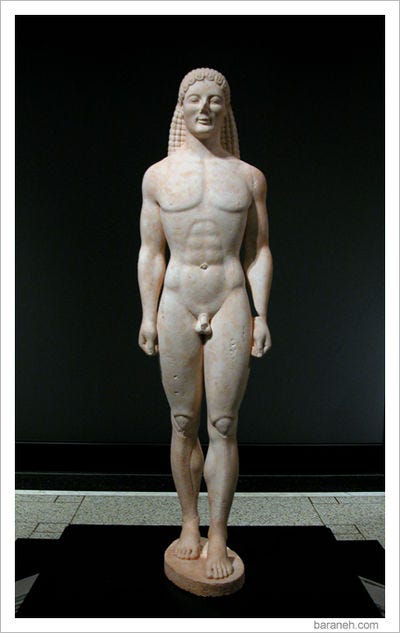Our gut feeling is a powerful decision-making tool. Yet we have a hard time trusting it.
Our world prefers ratio; analysis and logical reasoning are deemed superior.
But is that always the case?
The power of intuition
In 1987 the Getty Museum bought a beautiful kouros, an ancient Greek sculpture. The rare sculpture was one of the museum’s first claims to fame and the staff was elated. All the documents checked out, the marble was from the right Greek island, and spectroscopy put it at 3000 years old. But still something didn’t feel right…
When Thomas Hoving, conservator at the Met (another major museum), first saw the sculpture he exclaimed: “Oh dear”. Then and there he knew it was a fake. But Hoving was unable to explain why. Without a plausible explanation, the Getty wasn’t convinced and proceeded with the acquisition. Only years later the $10M statue turned out to be a fake. Hoving had known it all along.
Sometimes our instincts know more than our conscious mind. Our thoughts cannot always factor all the dimensions into a decision. It’s too complex. But our gut can.
Reasoning kills your gut
Logical reasoning can even kill your correct gut feeling. We find explanations that sound plausible and adjust our preferences to match them, or we oversimplify and lose track of how different parts of the problem interact.
When a group of school kids was asked to rate jams, their answers had a 0.85 correlation with those of jam experts. But when the next group was asked to explain why they liked a specific jam (taste, texture, etc.), the correlation dropped to 0.11! Having to explain their choice destroyed the ability of the test group to make an intuitive judgment.
Mastering your intuition
We should learn to trust the gut feeling of product teams that have experience and talent. This means their decision-making quality is high, and their intuition is well-trained.
Google’s 20% time - where they can work on anything they want - gives individuals carte blanche to follow their gut every Friday. It yielded innovations such as Gmail and Adsense.
I believe we can actively train our gut feeling. Thomas Hoving trained his’ by going through the collection of the Met every night with subject experts. Looking at one ancient object after another helped him develop a 6th sense. We should do the same for our craft:
Use the best & worst designed products, and analyze what works and what doesn’t
Talk regularly to your users, so you intimately understand their pain
Talk to other product teams, to learn from their approach
All this information and active thinking trains your unconscious mind; your gut.
So that when the time comes, you know what is “right” even when you can’t put it into words.
Getting buy-in for your intuition
But maybe you already know what the right thing is. Maybe your problem is that you can’t sell it to your leadership team; They want to see numbers and proof. So how do you convince them?
Show where in your plan you are making leaps of faith
Explain how you will validate your hypothesis
If you get it right for a number of lower-impact projects, you earn trust in your decision-making quality. That allows you to take on bigger and more important projects.
Going on the gut at VEED
At VEED.IO I’ve just started working on an exciting project: Our mobile app. The market for mobile video editors is extremely competitive, and as a company we have no experience in it. Although we had done the work to get the right inputs (market analysis, interviews, surveys) the decision on the scope of v1 of the app required trusting our intuition. We convinced our CEO that this is the right thing to do by making our assumptions clear, and explaining how we will validate them. Our first mobile video editor will focus on adding captions to videos and repurposing them quickly for different social platforms. We assume that this simple flow will get people to adopt VEED as a small, but integral part of their content creation workflow, after which we can expand our scope step by step.
Trust your intuition
There’s a time and place for analysis and logical reasoning, but it’s not sacred. Your gut feeling is a powerful tool that can solve some problems better and faster. But it’s a tool you need to develop. 3 take-aways to help you do just that:
Learn to trust your intuition
Actively train it by giving the right inputs (analyze your experiences with other products, talk to users, learn from other teams)
Convince your stakeholders your intuition is a valid input for decisions
If you’re new to Amsterdam Product Club, subscribe below for actionable lessons for product managers.
Until next month!





